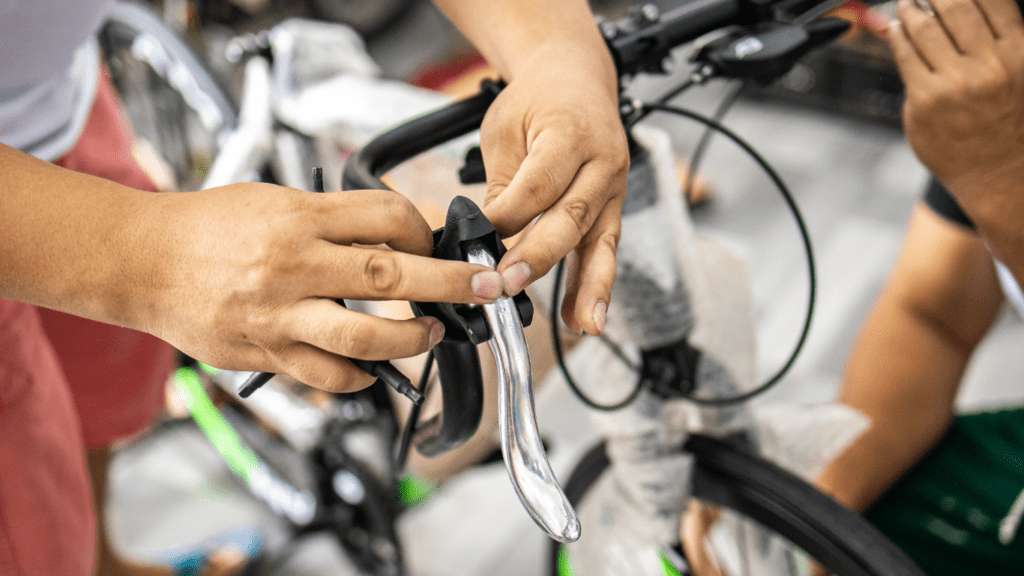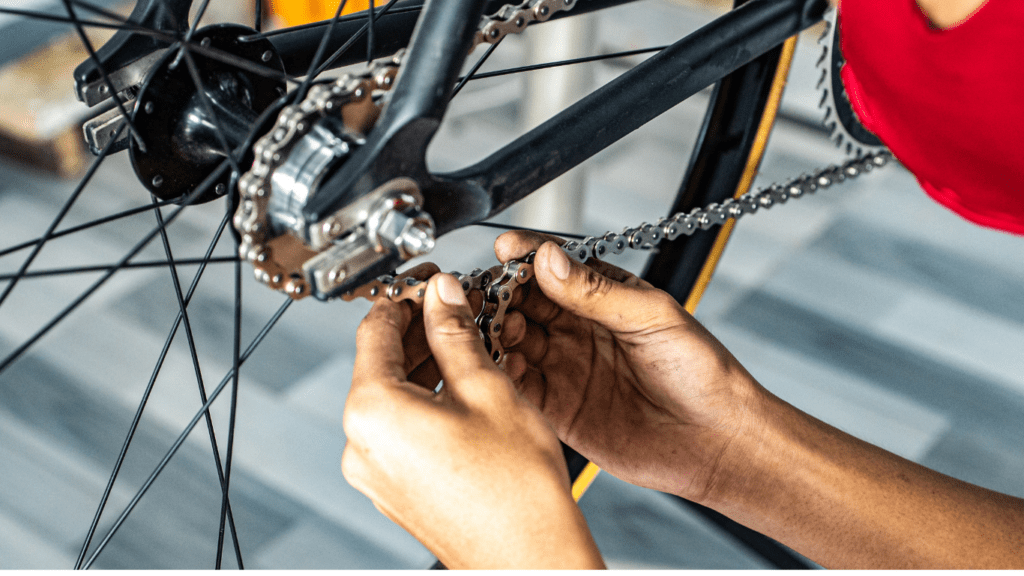Understanding Basic Bike Maintenance
Basic bike maintenance ensures rides are safe and enjoyable while extending the bike’s lifespan.
Importance of Regular Maintenance
Regular maintenance identifies and prevents issues before they become serious. Consistent checks improve performance and reduce unexpected breakdowns, making rides smoother.
I noticed fewer mechanical problems once I started a regular maintenance routine, making my cycling experience more reliable.
Tools Needed for Basic Maintenance
Essential tools streamline the maintenance process and allow for quick fixes. Here’s a list of crucial tools:
- Multi-tool: A compact solution with various Allen keys, screwdrivers, and sometimes chain tools.
- Tire Levers: Essential for removing tires when fixing flats.
- Patch Kit: Handy for repairing punctured inner tubes.
- Pump: A floor or hand pump to maintain tire pressure.
- Chain Lubricant: Keeps the chain running smoothly and prevents rust.
- Cleaning Brushes: Various sizes to clean different parts of the bike effectively.
These tools are readily available at most bike shops and online, ensuring you’re well-prepared for basic maintenance tasks.
Cleaning and Lubrication
Proper cleaning and lubrication keep your bike running smoothly. These steps extend the life of your components, reducing the risk of breakdowns during rides.
Washing Your Bike the Right Way
I recommend cleaning your bike thoroughly after every few rides, especially in muddy or rainy conditions. Use a bucket of warm water mixed with bike-specific cleaner. Avoid using high-pressure hoses, which can force dirt into sensitive areas like bearings. For cleaning tools, grab a sponge, soft brushes, and old toothbrushes.
- Rinse the bike gently using a low-pressure water source.
- Apply bike cleaner to the frame, wheels, and drivetrain.
- Scrub all parts using soft brushes or sponges. Use an old toothbrush for tight spots.
- Rinse off the cleaner thoroughly.
- Dry the bike with a clean cloth to prevent rust.
Lubricating Chain and Components
Lubrication is key to reducing friction and wear. A well-lubricated chain ensures smooth shifting and pedaling. Use chain lube designed for your riding conditions, whether wet or dry.
- Apply a drop of lube to each chain link while rotating the pedals backward.
- Let the lube sit for a few minutes to penetrate the chain.
- Wipe off the excess using a clean cloth to avoid attracting dirt.
- Lubricate other moving parts such as derailleurs and brake pivots with appropriate, lightweight oil.
These steps help maintain peak performance and prolong the bike’s lifespan. Regular cleaning and lubrication make every ride smoother and more enjoyable.
Tire Maintenance
Tires play a critical role in a bike’s performance. Proper maintenance ensures safety and efficiency on every ride.
Checking and Adjusting Tire Pressure
Regularly inspect tire pressure. Underinflated tires increase the risk of flats and reduce performance. Overinflated tires can lead to a rough ride and increased wear.
Use a reliable tire gauge to measure pressure, adhering to the manufacturer’s recommended PSI range, typically listed on the tire sidewall. Pump tires accordingly.
Repairing Punctures
Equip yourself with a puncture repair kit. Locate the puncture by inflating the tire and listening for escaping air or submerging it in water to spot bubbles.
Mark the puncture area, remove the inner tube, and gently roughen the area around the hole with sandpaper. Apply adhesive and a patch from the repair kit, ensuring a secure bond. Reinsert the tube, inflate the tire, and check for leaks.
Brakes and Cables
Maintaining brakes and cables ensures reliable stopping power and overall bike safety. Regular checks and adjustments prevent wear and potential accidents.
Inspecting and Adjusting Brakes

Inspect brakes regularly to identify wear and adjust them for optimal performance. Check for wear on brake pads; replace them if the grooves are no longer visible.
To adjust, first ensure brake pads align with the rim, then use an Allen wrench to tighten or loosen the brake cable tension. Test brakes by squeezing the levers; they should engage before being fully compressed.
If they don’t, adjust the barrel adjuster to tweak tension as needed. Properly aligned and adjusted brakes guarantee effective stopping power and safety.
Replacing Brake Cables
Over time, brake cables wear out, affecting braking efficiency. Replace brake cables if frayed or corroded. First, release tension by loosening the anchor bolt on the brake arm, then detach the old cable. Thread the new cable through the lever and cable housing, ensuring smooth movement without kinks. Secure the new cable to the brake arm by tightening the anchor bolt. Finally, adjust the tension and test the brakes. New, well-installed brake cables restore reliable braking performance.
Checking and Adjusting Gears
Maintaining proper gear function ensures smooth shifting, enhances riding efficiency, and prevents component wear.
Importance of Proper Gear Alignment
Gear alignment impacts shifting performance and overall ride quality. Misaligned gears cause chain skips, making the ride uncomfortable and potentially damaging the drivetrain. Frequent inspections and adjustments maintain optimal gear alignment.
How to Adjust Your Bike’s Gears
Fine-tuning gears involves several steps.
- Inspect Derailleur Hanger: Ensure it’s straight; a bent hanger affects shifting. Use a derailleur alignment tool or consult a professional if necessary.
- Adjust Barrel Adjuster: Locate the barrel adjuster on the derailleur. Turn it counterclockwise to reduce cable tension or clockwise to increase it. This fine-tunes the derailleur’s position.
- Set High and Low Limit Screws: Identify the high (H) and low (L) limit screws on the derailleur. Adjust the H screw so the chain aligns with the smallest cog. Adjust the L screw for alignment with the largest cog.
- Indexing Gears: Shift through all gears while turning the crank. Listen for smooth transitions. If shifting feels rough, adjust cable tension using the barrel adjuster.
- Test Ride: Take a brief ride to ensure smooth and responsive gear changes. If any issues persist, repeat the adjustments.
Regular gear maintenance improves performance, making your rides more efficient and enjoyable.

 I’m Brendamee McCartyierr, and as the founder of Cycle Smooth Ride Long, I'm thrilled to bring you the ultimate resource for all things cycling. Whether you're a seasoned rider or just starting on your cycling journey, our mission is to support your passion for two wheels with trusted advice, insightful reviews, and expert tips.
Cycling is more than just a hobby—it's a lifestyle that promotes health, freedom, and adventure. At Cycle Smooth Ride Long, we’re committed to making your ride smoother, longer, and more enjoyable by providing you with the latest in cycling news, nutrition advice, fitness tips, and gear reviews. We also cater to beginners, offering comprehensive guides to help you get started and build confidence on the road.
I’m Brendamee McCartyierr, and as the founder of Cycle Smooth Ride Long, I'm thrilled to bring you the ultimate resource for all things cycling. Whether you're a seasoned rider or just starting on your cycling journey, our mission is to support your passion for two wheels with trusted advice, insightful reviews, and expert tips.
Cycling is more than just a hobby—it's a lifestyle that promotes health, freedom, and adventure. At Cycle Smooth Ride Long, we’re committed to making your ride smoother, longer, and more enjoyable by providing you with the latest in cycling news, nutrition advice, fitness tips, and gear reviews. We also cater to beginners, offering comprehensive guides to help you get started and build confidence on the road.
